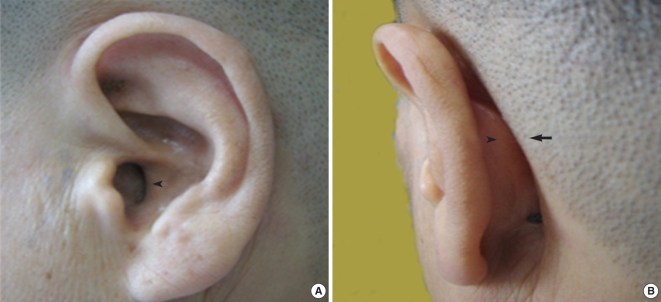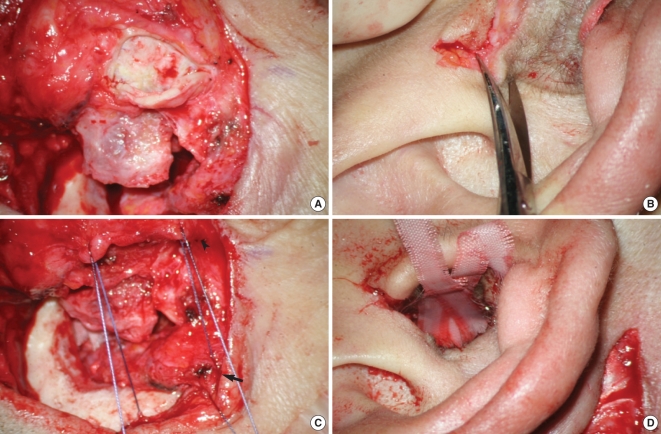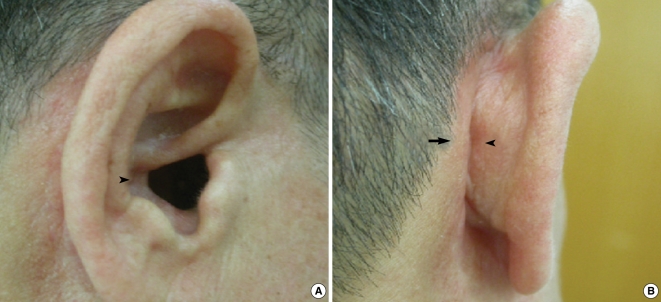Clin Exp Otorhinolaryngol.
2009 Dec;2(4):164-168. 10.3342/ceo.2009.2.4.164.
A Novel Meatoplasty Method in Canal Wall Down Tympanomastoidectomy: A Perichondrial Posterior Fixation Technique
- Affiliations
-
- 1Department of Otorhinolaryngology, Seoul National University College of Medicine, Seoul, Korea. suno@snu.ac.kr
- 2Sensory Organ Research Institute, Seoul National University Medical Research Center, Seoul, Korea.
- KMID: 1466492
- DOI: http://doi.org/10.3342/ceo.2009.2.4.164
Abstract
OBJECTIVES
Although it is well recognized that a small meatus after canal wall down (CWD) tympanomastoidectomy can cause a lifetime problem, unsatisfactory results are frequently encountered. We herein introduce a novel technique, perichondrial posterior fixation (PPF), to maintain a wide external auditory canal (EAC), to minimize postoperative wound infection due to the smaller dead space and to improve the posterior auricular cosmetic outcome. METHODS: A total of 73 patients who underwent CWD tympanomastoidectomy were included. Interventions are CWD tympanomastoidectomy with the PPF technique. Review of the medical records and evaluation of the postoperative size of the meatus and the extent of the cavum conchal cartilage buried within the mastoid cavity by taking digital photographs. RESULTS: Thirty males and 43 females were included and the mean age was 44.1 yr (range, 6 to 66 yr). The mean follow-up duration was 26 months (range, 12 to 56 months). All ears maintained a clean and large external meatus. The posterior auricular cavum conchal cartilage was successfully prevented from being buried into the mastoid cavity in all ears. The extent of cartilage buried into the mastoid cavity was much reduced compared to the conventional technique. CONCLUSION: The PPF technique, which is a novel meatoplasty technique in CWD tympanomastoidectomy, seems to be effective in maintaining a large external meatus and improving the cosmetic outcome with minimal risk of complications.
MeSH Terms
Figure
Cited by 1 articles
-
Management of Attic Cholesteatoma While Preserving Intact Ossicular Chain; “Modified Bondy Technique” vs. “Canal Wall Up Mastoidectomy with Tympanoplasty Type I & Scutumplasty”
Dan Bi Shin, Jung On Lee, Tae-Uk Cheon, Jung Gwon Nam, Tae-Hoon Lee, Joong Keun Kwon
Korean J Otorhinolaryngol-Head Neck Surg. 2017;60(10):491-496. doi: 10.3342/kjorl-hns.2017.00087.
Reference
-
1. Roulleau P. Development of the surgery of chronic otitis. Rev Laryngol Otol Rhinol (Bord). 1993; 114(2):87–91. PMID: 8284561.2. Fisch U, Chang P, Linder T. Meatoplasty for lateral stenosis of the external auditory canal. Laryngoscope. 2002; 7. 112(7 Pt 1):1310–1314. PMID: 12169919.
Article3. Paparella MM, Kurkjian JM. Surgical treatment for chronic stenosing external otitis (Including finding of unusual canal tumor). Laryngoscope. 1966; 2. 76(2):232–245. PMID: 5324121.4. Soliman T, Fatt-Hi A, Abdel Kadir M. A simplified technique for the management of acquired stenosis of the external auditory canal. J Laryngol Otol. 1980; 5. 94(5):549–552. PMID: 7400681.
Article5. Hunsaker DH. Conchomeatoplasty for chronic otitis externa. Arch Otolaryngol Head Neck Surg. 1988; 4. 114(4):395–398. PMID: 3348895.
Article6. Mirck PG. The M-meatoplasty of the external auditory canal. Laryngoscope. 1996; 3. 106(3 Pt 1):367–369. PMID: 8614206.
Article7. Eisenman DJ, Parisier SC. Meatoplasty: the cartilage of the floor of the ear canal. Laryngoscope. 1999; 5. 109(5):840–842. PMID: 10334243.
Article8. Suskind DL, Bigelow CD, Knox GW. Y modification of the Fisch meatoplasty. Otolaryngol Head Neck Surg. 1999; 7. 121(1):126–127. PMID: 10388893.
Article9. Raut W, Rutka JA. The Toronto meatoplasty: enhancing one's results in canal wall down procedures. Laryngoscope. 2002; 11. 112(11):2093–2095. PMID: 12439187.
Article
- Full Text Links
- Actions
-
Cited
- CITED
-
- Close
- Share
- Similar articles
-
- Modified Canal Wall Down Mastoidectomy Without Meatoplasty
- Clinical Review of Chronic Otitis Media in Patients with Contracted Mastoid
- Reconstruction of the Posterior Canal Wall with Silastics in Chronic Otitis Media Surgery
- Mastoid Obliteration with Bone Paste and Fat
- Prevention of Chondritis with '' Type Perichondrial Flap in Vertical Partial Laryngectomy after Radiation Failure: Preliminary Report





